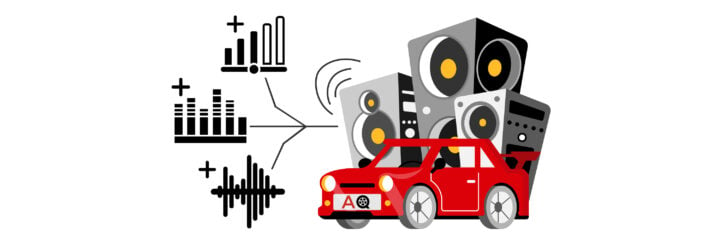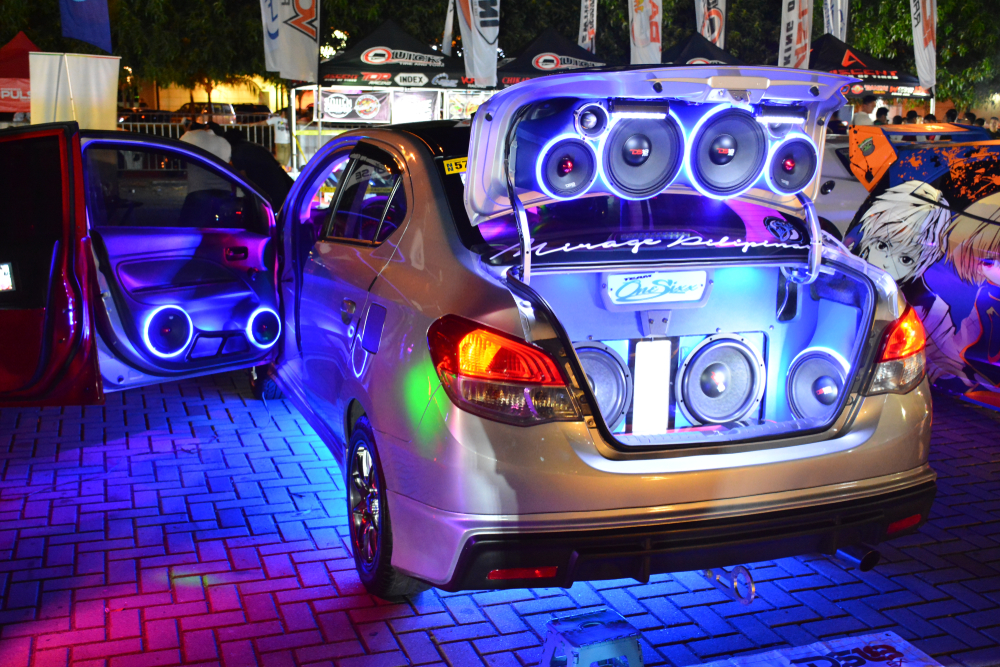Factory car sound systems are never powerful enough for any audio enthusiast. In many cars, the factory system doesn’t even have enough oomph to compete with road-noise. What good is a car stereo if you can’t hear it over the sound of your tires?
That’s where a car amp comes in. As the name suggests, a car amp amplifies the electrical signal from a source so that the speakers get more juice. Speakers with more power will have better sound quality and allow you to hear your favorite music over the road noise. You can also use an amp to blow the doors off with bass if it’s not enough to be a little louder.
- Finding the Best Amp for Your Car
- Top 10 Best Car Amplifiers 2025
- 1. Best Overall Amp: Rockford Fosgate 5-Channel
- 2. Best Budget Amp: Boss Audio R1100M
- 3. Best Premium Amp: Rockville dBocm5
- 4. Best Bluetooth Amp: Rockville RXM8BTB
- 5. Best Class D Monoblock Amp: Rockford Fosgate R500
- 6. Best 5 Channel Amp: Alpine PDR-V75
- 7. Most Affordable High-Power Monoblock Amp: Skar Audio RP Series
- 8. Best Power Pack Amp: Alpine KTP-445U
- 9. Most Affordable 4 Channel Amp: Blaupunkt 1500w
- 10. Most Affordable Bluetooth Amp: Herdio HMR502B
- The Complete Car Amplifier Guide
- Get the Earplugs Ready
Finding the Best Amp for Your Car
Car audio amplifiers come in hundreds of styles and configurations, so it can be hard to know what you need to get the most out of your system.
This should be all you need to make a purchasing decision, but down the page is a much more in-depth guide for those who really want to fine-tune their audio knowledge.
Before you start looking at amps, here is everything you must know.
- How many speakers will you be powering?
- Will you be powering a subwoofer?
- What is the RMS rating of the speakers you will be powering?
- How much space do you have to work with?
- What will you use as the source of your sound system?
- What can you afford?
How Many Speakers Will You Be Powering?
Amplifier outputs are separated into channels. Generally speaking, each channel can power one speaker. The average car has four channels: a front left, front right, rear left, and rear right.
Commonly amps will have either 1, 2, 4, or 5 channels. Some amps will have more, and some cover a range. For the most part, just count the number of speakers you will need to power and get that many channels.
If you’re looking for some new speakers to match your amp, be sure to check out our guide to the best car speakers on the market today.
Will You Be Powering a Subwoofer?
This category is the most straightforward. Some amps do not have enough power to drive a subwoofer.
A monoblock amplifier is a one channel amp that is built to power a subwoofer. They usually have features that are just for subs, like bass equalizers and high pass filters. If you are just adding a sub to an existing system, monoblocks are for you.
Otherwise, just make sure the amplifier can put out the power needed for your bass setup.
What Is the RMS Rating of the Speakers You Will Be Powering?
Amp output is measured in watts. Most amps will boast about their “max wattage” on the box, but that’s not what you should ever care about. Watts RMS, which stands for root-mean-square, is the number you want to pay attention to.
Your speakers will also have an RMS rating, sometimes expressed as a range like 2w-10w. To choose an amp, you want to work with the top of the range, so 10 watts RMS is that speaker’s rating.
Speakers will also have an ohm (Ω) rating, almost always either 2 or 4. Most amps will have a separate RMS rating for 2 ohms and 4 ohms listed..
Get an amp that is closest to the ratings of the speakers.
For example, if you have a subwoofer with “2Ω and 300w RMS” printed on the back, get an amp with a 300w RMS channel at 2 ohms. A little over or under won’t hurt. Going way over the rating, like getting 1000w at 4 ohms, will just blow your speakers.
How Much Space Do You Have to Work With?
You will have to plan where you want your audio inputs and outputs before buying an amp. Nothing will ruin your day faster than finding the perfect amp and finding out it does not fit in your ride. Make sure to get the tape measure out and double-check.
Consider whether or not you want the amp to be seen at all. Some people get a lot of pride in showing off their audio equipment, but some want to keep it out of sight. Some of the amps in this guide are small enough to hide behind the dashboard. With those small amps, you can keep a car looking factory while still providing extra punch.
What Will You Use as the Source of Your Sound System?
Amplifiers for cars have two main inputs: RCA and high-level. RCA, or low-level, inputs come from a preamp. High-level, also known as speaker-level, uses the same wires that already go to your speakers.
Most factory head units, and even a lot of aftermarket ones, don’t have RCA out. That means an amp without high-level inputs will not work with a factory sound system, something you must keep in mind if you don’t plan on upgrading your source.
If you are looking for a new head unit, be sure to check out our list of the best touch screen car stereos.
A workaround that is growing in popularity is Bluetooth. Some amps can accept a Bluetooth audio signal and work right from your phone or device. It’s a good option if you do not want to run new wires or drive a vehicle with no head unit.
What Can You Afford?
It’s the question no one really wants to think about, but you must know its answer. There are amps in this guide that will cost you thousands of dollars to utilize. On the flip side, there is one amp on this list that will simply boost your factory audio for less than two hundred dollars total.
Remember that an amp is only part of the car’s audio system. Big high output amps need big, high output speakers. Some amps will even require you to upgrade the car’s entire electrical system.
Amps come in many flavors, so it’s hard to know where to even start when you are looking to buy. That’s why we covered all the bases with these 10 choices. You are guaranteed to find one that suits your sound system.
Top 10 Best Car Amplifiers 2025
1. Best Overall Amp: Rockford Fosgate 5-Channel
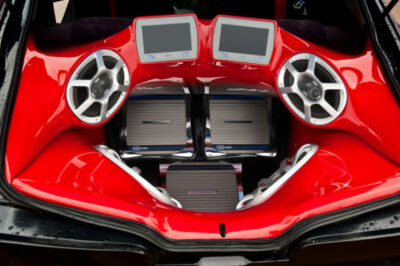
Editor’s Rating:
At a Glance:
- 5 channels
- 4 x 50w + 1 x 200w RMS at 4 ohms, 4 x 75w + 1 x 300w RMS at 2 ohms
- Class A/B and D
- Speaker level and RCA input
- Features include: Remote level controls, a large heatsink, overcurrent and short circuit protection, and onboard EQ
Who Is This Amp Best For?
The Rockford Fosgate 5 Channel is best if you just want to buy one amp and be done with it. You get 4 channels for your speakers and a dedicated subwoofer channel for bass, which is everything you need to power most systems.
You also get more knobs and buttons than on a space shuttle. That way you can tune the sound to perfection. With the high-level and RCA inputs and near-limitless output configurations, the answer to the question “will it work with your system” is yes.
Quality
Rockford is no slouch when it comes to quality. They’ve been in the game for a long time and manufacture bulletproof products. They also pride themselves on prioritizing audio quality.
This amp has short detection and current protection on top of good quality internals. You don’t have to worry about it letting you down.
Design
The one downside to the Fosgate 5-channel is the size. It’s a big unit, and if space is at a premium you might have trouble finding a place to install it.
It’s got a guitar amp style to it that is unique in the car audio world, though, so the fact that you can’t hide it anywhere might not be so bad.
Power
75w RMS is average for a multi-channel amp, and 300w RMS for a sub is adequate. Even though there are more powerful 5-channel amps, you’ll still get really good volume and clarity out of your system with Rockford.
Value
The price tag is a little high, but the Rockford’s high quality and ability to power an entire system make it first class in value.
Pros
- 5 channels for handling almost every situation
- Great value
- Onboard EQ for fine-tuning
- A lot of input and output options
Cons
- It’s big
- It can run hot
2. Best Budget Amp: Boss Audio R1100M
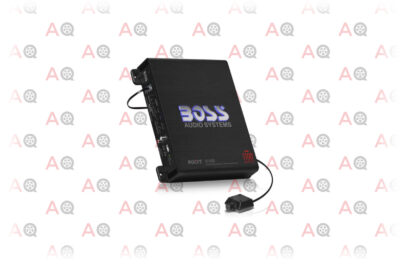
Editor’s Rating:
At a Glance:
- 1 channel
- 825w RMS at 2 ohms, 413w RMS at 4 ohms
- Class A/B
- Speaker Level and RCA input
- Features include: Remote subwoofer controller, variable filter, short protection
Who Is This Amp Best For?
Boss is probably the most significant player in the budget amp category, and the R1100M is a perfect example as to why. If you are looking for the most straightforward and budget-friendly amp to add a decent subwoofer to your audio system, here it is.
This amp has high and low-level inputs, so it will work with any head unit. It also has a low pass filter and a bass booster. It is perfect for an entry-level audio upgrade.
Quality
Boss is known for being a good quality for the price. It doesn’t have the highest audio quality or the best internals, but for its cost it still has really good build quality.
It also doesn’t have the internal protections that more expensive amps have. It has short protection, which is useful for some overheating scenarios. Beyond that, though, you won’t be protected from overcurrent or prolonged thermal issues.
That doesn’t mean these amps won’t last, and as long as you install them right, you won’t have any issues.
Design
The Boss R1100M has a straightforward layout, with controls and inputs on the front and outputs and power on the back. It’s somewhat compact at about ten inches square. It also comes with a remote subwoofer control to mount anywhere and still set your level.
Power
The Boss claims to put out 825w RMS, but it doesn’t quite make that much power in the real world.
That doesn’t mean it’s low on power. It will add bass to your system that is more than loud enough to punch through the rest of your music. You just won’t be shattering windows like you would with other amps.
Value
The simple fact is that you would have to pay a lot more to get more power or more features. If you don’t need those extra features, you can’t beat this amp.
Pros
- Budget-friendly
- High-level inputs
- Simple, user-friendly design
- Good amount of power
Cons
- Low on features
- Not many customization options

Editor’s Rating:
At a Glance:
- 1 channel
- 3,500 watts RMS at 1 ohm, 2,200 Watts RMS at 2 ohms
- Class D
- RCA input
- Features include: Digital display, remote level control, variable Filters, full EQ
Who Is This Amp Best For?
This Rockville Amp has everything you need to shake the neighborhood. 3,500 watts RMS is a massive amount of raw oomph.
It doesn’t sacrifice any features to get that oomph either. It’s got more than we can list in a limited space. The highlights include fully adjustable filters, phase controllers, clip indicators, and a fully adjustable equalizer.
Just be warned that if you don’t need the raw power, you’ll be spending well over $300 to generate heat. Unless you have a huge sub and can take advantage of that energy, this amp isn’t really for you.
Quality
Rockville only uses premium internals. As a company, they know that the amps they build will be out there at shows and events in sound competitions, so they know they can’t risk delivering faulty products.
The amp is completely protected too. It has full IC protection, soft start, overvoltage, and under-voltage protection. That way you can sleep easy knowing your high priced equipment is safe.
Design
In addition to being an absolute powerhouse, the brushed aluminum case is beautiful. If you want people to walk up and gawk at your sound setup, here’s your centerpiece.
The hard part is that you will be designing your system around this amp. It’s nearly two feet long and needs to be fed by gigantic power cables.
Power
This is the most powerful monoblock in this guide, and only the Skar comes close. It needs to be protected by a 450 amp fuse and fed by 1/0 gauge electrical wires. It will shatter your eardrums without much issue. Just make sure you have speakers that can handle it.
Value
If you are trying to build the ultimate sound system, you need components like this amp to be the heart. That makes it worth it.
Pros
- Ultra-high quality
- Lots of oomph
- 1 ohms stable
- Tons of customizability
Cons
- Expensive
- Not beginner-friendly at all
4. Best Bluetooth Amp: Rockville RXM8BTB
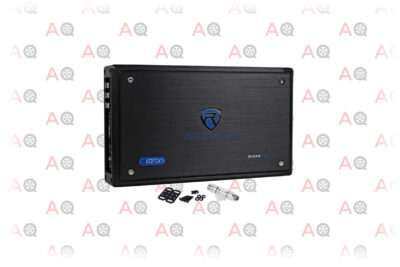
Editor’s Rating:
At a Glance:
- 8 channels
- 8 x 65w RMS at 4 ohms, 8 x 95w at 2 ohms, or bridged 4 x 190w RMS at 4 ohms
- Class D
- RCA or Bluetooth input
- Features include: Selectable filters, equalizers, waterproof, configurable outputs
Who Is This Amp Best For?
No head unit? No problem, the Rockville RXM8BTB accepts Bluetooth input straight from your phone.
Might get messy inside your car? No problem, the Rockville is marine grade and water-resistant.
Do you need more power than other Bluetooth and waterproof amps can offer? No problem, the Rockville can drive up to 8 speakers at 95w RMS.
This amp also has a dedicated bass equalizer to get the most low end out of the speakers. Finally, it’s got fully adjustable and channel-dependent filters to dial it in any sound profile.
Quality
Since the RXM is a marine amplifier, it can stand up to anything. Saltwater is notorious for ruining everything it touches, so they coated the case in UV and saltwater resistant paint. Then Rockville covered the internals in corrosion-resistant material, so the amp is protected inside and out.
You also get the full complement of circuit protection. Heat, shorts, and overloads won’t break it, and the heavy-duty aluminum frame will even protect it from impact. If there’s any amp that can be classified as indestructible, it’s this Rockville.
The only thing that might let you down is the Bluetooth audio quality. It’s prone to extra noise and distortion. To get the most out of this amp, it’s better to have a separate receiver.
Design
At a foot long and seven inches wide, the RXM doesn’t seem small until you realize that it’s packing 8 separate channels into its aluminum body.
Plus, if you want to, you can cast tradition aside by selecting the bright white color option.
Power
You can drive 8 speakers with 95w of power. That’s a lot, no matter how you slice it. The only thing you might miss is a dedicated subwoofer channel. It can still power a decent sub but you will just have to bridge a couple channels together.
Value
Honestly, with the features and number of channels that this amp has, it’s hard to believe the price. Just keep an eye on the temperature.
Pros
- Weatherproof
- Massive number of output options
- Good amount of power per channel
- Bluetooth
Cons
- Prone to overheating if not dialed incorrectly
- Bluetooth quality is not great
5. Best Class D Monoblock Amp: Rockford Fosgate R500

Editor’s Rating:
At a Glance:
- 1 channel
- 500 Watts RMS at 2 ohms, 300 Watts RMS at 4 ohms
- Class D
- High-level and RCA input
- Features include: Compact design, remote level control and onboard EQ
Who Is This Amp Best For?
The Rockford Fosgate is just a great little amp. It’s not the cheapest thing on this list, and it’s not the most powerful, but it does give you really clear audio from a very compact, easy to install unit.
The big distinction between the R500X1D and the less expensive rivals is that it is a class D amp. That means you turn as much power as you can into noise instead of heat.
You will probably be comparing this Rockford to the Boss. To keep it simple, if your only goal is to get loud, go for the Boss. If you care about audio quality, get the Rockford.
Quality
You don’t have to worry about a Rockford amp. It will take whatever you want to throw at it.
With a big aluminum heatsink, short circuit, and overcurrent protection, it will keep working even if you run it at full power. If you manage to overheat it, the thermal sensor will shut the unit off to protect the insides.
Design
The Fosgate is a little different than most monoblock designs. It has the inputs and outputs on the bottom, and the controls on the face. That can give you some extra options for mounting it since you only need to access one side for wiring.
It’s also ultra-compact. At a mere 8.5×6.8 inches in size, it’s the smallest monoblock in this guide.
Rockford likes to keep their identity across models, so you still get their signature old school style despite the small size.
Power
500w at 2 ohms is plenty to power a modest subwoofer. You won’t be winning any competitions, but it still makes excellent power for the size.
Value
Great audio quality sets the Rockford R500X1D apart from its rivals, which makes it worth the extra cost.
Pros
- A lot of features
- Compact and easy to install
- Good quality
Cons
- More expensive than its rivals
- Mounting holes are difficult to work with
6. Best 5 Channel Amp: Alpine PDR-V75
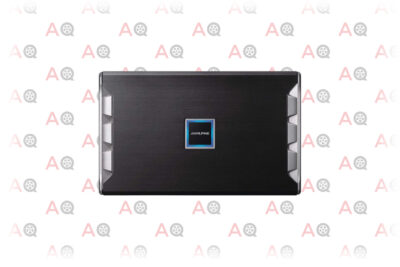
Editor’s Rating:
At a Glance:
- 5 channels
- 4 x 75w + 1 x 250w RMS at 4 ohms, 4 x 100w + 1 x 350w RMS at 2 ohms
- Class D
- Speaker Level and RCA input
- Features include: Remote level controls, large heatsink, overcurrent protection, short circuit protection, onboard EQ, a subsonic filter, and special sound tuning
Who Is This Amp Best For?
The Alpine PDR is the high tech competitor to the Rockford 5-Channel. It is smaller, has better heat management, more power, and the Alpine logo glows blue while it’s powered on.
As with other 5-channels, the PDR can do it all. Unlike other 5-channels, each channel and output on the Alpine can be customized or bridged. The speaker combinations you can get from this amp are nearly limitless.
If you want to dial in the best sound possible, the PDR has variable filters, variable EQs, subsonic filters, and some of the best internals on the market.
Quality
Alpine amplifiers are individually tested and rated. They try very hard to maintain their status as a premium, high-quality audio company, and it shows.
The insides are protected by advanced heat dispersion designed into the entire unit, and it has multiple layers of current protection.
Design
The ultra-compact form factor makes the Alpine a good option if space is any kind of concern. Even with 5 channels and one of the most robust cases on this list, the PDR is smaller than many monoblocks.
In the looks department, the Alpine oozes high tech. It features a glowing blue logo, aluminum trim and beveled corners will make you feel like the future is here.
Power
100w RMS on 4 channels with 350w for the subwoofer means you can drive some serious speakers. Unless you plan on running a giant sub, you won’t find anything to complain about in the power department.
Value
The high price of the amp extends beyond the initial cost. The Alpine does not have speaker level inputs, and you’ll need a good source to take advantage of the sound quality.
If your only goal is quality, though, you can’t go wrong.
Pros
- 5 channels for handling almost every situation
- Fantastic sound quality
- Tons of tuning options
- Ultra-Compact design makes it very convenient for any build
Cons
- High price tag
- No high-level input
7. Most Affordable High-Power Monoblock Amp: Skar Audio RP Series
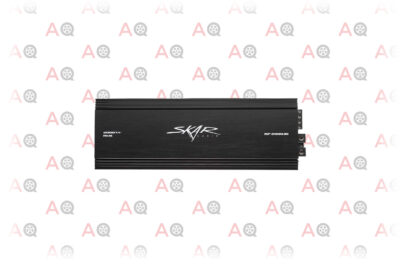
Editor’s Rating:
At a Glance:
- 1 Channel
- 2,000 Watts RMS at 1 ohms, 1,400 Watts RMS at 2 ohms, and 800 Watts RMS at 4 ohms
- Class D
- RCA input
- Features include: 4-way circuit protection, remote level control, low pass and subsonic filters
Who Is This Amp Best For?
If you need some serious power for your sub but the Rockville dBocm5 isn’t in your budget, take a look at this. The Skar RP-2000 is a high-quality class D amp built for raw power that is a lot more wallet-friendly.
Like the Rockville, the Skar is not an amp that you can just add to any audio system. It still needs serious cables and a ton of room.
If that doesn’t scare you, the Skar offers a lot of nice features. It has EQ switches, low pass filters, and subsonic filters to eliminate all the noise you don’t want from a sub.
Quality
Skar prides itself on using high-quality internals that can survive the maximum wattage lifestyle. The case is engineered to be a high-efficiency heat sink so you can crank the volume for long periods without that annoying high-temperature cutoff killing your sound.
On the inside, the Skar has all the protection you’d expect from a high-quality unit. It’s protected from shorts, overheating, low voltage, and over current situations.
Design
This absolute beast is eleven pounds, two feet long, and seven inches wide. You won’t be hiding this amp under your seat. You especially won’t be hiding it after you run the massive 1/0 gauge power cables.
The extra thick metal shell is part of the heat dispersion technology, so you don’t want to box it in. At least it isn’t bad looking: the Skar has a raw look that prioritizes form over function.
Power
With 2000 watts RMS at 1 ohms, you can power two subwoofers at 1000 watts each. You might not be as loud as the car running the Rockville amp, but you can still wake the dead.
That much power is not for the neophyte, though. It’s less than the Rockville, sure, but it still uses a 200amp fuse for protection. It can output more than enough power to hurt you, make sure you know what you are doing if you pick up a high power amp like this.
Value
The Skar is an excellent compromise between price and power output.
Pros
- Very powerful
- 1 ohm stable
- Low pass and subsonic filters
Cons
- Needs a lot of work to install properly
- Expensive
8. Best Power Pack Amp: Alpine KTP-445U

Editor’s Rating:
At a Glance:
- 4 channels
- 4 x 45w RMS at 4 ohms or 2 ohms
- Class D
- Runs off the same power circuit as the head unit uses the same speaker wires for input and output
Who Is This Amp Best For?
The Alpine KTP-445U is different from everything else on this list. Unlike other amps, the KTP does not need any additional cables or devices. Simply splice it in between your current head unit and your speakers, and you are done.
You’ll get 45w over 4 channels, which is a little low when compared to other 4-channel amps. If you are willing to mount a larger amp and run a dedicated power line, you can get more watts and features for less money.
What you won’t get with other amps is something that has this combination of quality and simplicity. The Alpine KTP-445U is perfect for a quick upgrade to your factory sound system, especially if you just need a bit more power for newly upgraded speakers.
Quality
The KTP is simple, so there’s just not much to it that can break. Alpine only uses good quality parts, and it doesn’t even have knobs or switches that can break off.
The simplicity does have a downside, though: this amp has no protections. If you accidentally short it out, it’s done for. Make sure to follow the directions on installation.
Design
Alpine has engineered the KTP to be as compact as possible, so you can hide it almost anywhere. This is especially great if you have something like a classic car. You can splice in this little amp, get modern power to your speakers but keep the original radio.
The only issue you might have with the design comes from the lack of mounting holes and cable management. The unit itself is just a small black box with wires sticking out of it. That leaves you to figure out how to attach the thing and make it look good.
Power
The 45w RMS might not seem like very much, but most factory sound systems run at around 10 watts RMS. If you have ever had your music drowned out by the wind noise from an open window, you know that 10 is not enough.
As a simple upgrade for a factory system, 45w is more than enough to get you rocking.
Value
It might not be the most powerful, but no other amp is this easy to install. Since time is money, you are looking at a great deal.
Pros
- Incredibly easy to install
- Works with any system
- Good quality
Cons
- Lacks features
- Not very powerful
9. Most Affordable 4 Channel Amp: Blaupunkt 1500w
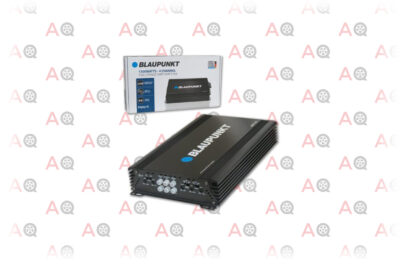
Editor’s Rating:
At a Glance:
- 4 channels
- 4 x 150w RMS at 4 ohms, 4 x 300w at 2 ohms
- Class A/B
- RCA input
- Features include: High-pass or low-pass filter, bass boost, and chain-ability
Who Is This Amp Best For?
At a glance, the Blaupunkt is just an average 4 channel amp. What sets it apart is the price tag. If you are building a sound system and budget is your primary concern, then take a look. These things can get you to 150w RMS per channel for less than $80.
The Blaupunkt has a surprising number of features for the price as well. You get enough power to drive bigger speakers, and you can tailor in the sound using a high pass filter or low pass filter.
Blaupunkt chose not to include high-level inputs, though, only RCA. The unit costs so little you could buy a new head unit with a preamp, and still come in cheaper than the less powerful Alpine KTP.
Quality
Looking at the Blaupunkt quality, you find out how they were able to cut the cost down so much. The quality is just not at the level of the big name brands on this list.
That manifests in a lot of little annoying ways. The actual amp output varies between units even from the same factory run. The amps run hot and have limited thermal protection, and no fault or overcurrent protection.
They work great and can last a long time, but you have to take an active role in making sure that happens. Keep the volume in check, make sure connections are tight periodically, and make sure the wiring is done right.
Design
It’s a basic amp with a basic design. The aluminum case isn’t hard to look at or anything, and the simple one side in, one side out design is what you expect from a budget amp.
The only complaint is that the mounting tabs are thin. There are four of them, so if a few break off, you still have options. Just make sure you don’t rely on only one to secure your amp.
Power
150w RMS on 4 channels is more than enough to cause you to go deaf. You can run a sub, no problem. The only people who have amps that bring a lot more volume than thiss will have paid a lot more.
Value
If you can deal with the occasional quality issue and have RCA outputs, this amp is a great value.
Pros
- Very inexpensive
- Good power output, especially for the price
- Decent fine-tuning capabilities
Cons
- No high-level input
- Quality isn’t great
10. Most Affordable Bluetooth Amp: Herdio HMR502B

Editor’s Rating:
At a Glance:
- 4 channels
- 4 x 45w RMS at 4 ohms
- Class A/B
- RCA, AUX and Bluetooth input
- Features include: Waterproof case, USB charging, and ultra-compact design
Who Is This Amp Best For?
The Herdio HMR is a small, waterproof amp that has four channels and Bluetooth input. It’s the smallest amp on this list, about the size of a big cell phone, and still manages to produce 45w of power using whatever 12v source you can find.
That makes it the perfect amp for a track day car or offroader. If you have a track toy with no radio and no roof, but you still want to listen to tunes on the way to the AutoCross, just throw one of these under the dash. If you have a Jeep with no top and want to blast tunes neck-deep in mud, here you go.
Quality
If you compare the Herdio to the other Bluetooth, waterproof amp in this guide, you will notice a stark contrast in quality.
The Rockville has a thick aluminum case painted in corrosion-resistant material. It also has internal circuit protectors and advanced heat dispersion.
The Herdio has none of those things.
Despite that contrast, the Herdio has no problem surviving the elements. It’s not uncommon for people to use these on their ATVs, side-by-sides, and snowmobiles to enjoy tunes out on the trails.
Design
This amp is eight inches by four inches and comes with handlebar mounts. You can mount this to a motorcycle and run some nice sized speakers, it’s that compact.
The controls are a bit different. Rather than a head unit or control panel, you get a remote. Other than that, it’s a nondescript metal box.
Power
Like the Alpine Powerpack, the Herdio only gives you 45w per channel. That’s not great, but it is an upgrade over any factory system. You will hear it over a motorcycle engine or the roar of off-road tires on the highway.
You won’t be driving a sub with this little unit, though.
Value
If you just want a little amp to throw onto your ride and enjoy decent enough sound, the Herdio won’t let you down.
Pros
- Inexpensive
- Tiny
- Bluetooth capable
Cons
- Low on features
- Sound quality isn’t great
The Complete Car Amplifier Guide
Hopefully no one ever told you that amps are not complicated. Don’t worry, though. With this guide, we are giving you everything you need to know to understand and purchase the perfect amp for your car.
An Amp Is Only One Part of the Sound System
When you choose an amp, you will have to decide what your sound system will be in its final form, not what it is right now. It’s easy to just drop a small amplifier into the factory system and get the speakers loud. It’s a whole new world of parts and accessories if you want to start getting competitive.
A factory sound system is simple. The head unit is powered by the battery and is connected directly to the speakers.
When you start getting into custom sound systems, things can get a lot more complicated. Adding in an amplifier often means running all new electrical and speaker wires. As systems get advanced, they introduce the components most people don’t know about like crossovers.
If you start pushing things to the extreme, you will be looking at a complete overhaul of the car’s electrical system. Bigger alternators, extra batteries, and massive cables are things you will need to push the limits.
Common Configurations for Amp Channels
Amp outputs are called channels. A 4 channel amp will have, you guessed it, 4 outputs. Generally, each channel can only handle one speaker. There are cases where you can hook multiple speakers to one channel. Those cases involve a good understanding of resistance. and are somewhat rare in car audio systems.
Amps can come with any number of channels. These are the 5 most common configurations:
- One channel, or monoblock amps like the Boss Audi R1100 amplifiers have one channel. Usually, you use a monoblock amp to power a subwoofer. A monoblock with a sub is a great first upgrade to your car’s system. You can add other equipment like upgraded speakers and wiring down the road, and you won’t have to worry about running out of bass.
- 2 or 4 channel amps like the Alpine KTP amps are your general-purpose amplifiers. A two-channel amp generally just has a left and a right. A four-channel will have left and right plus front and rear. This is your classic stock setup, so if you just want to rattle your windows without adding any new speakers, these are good amps to buy.
- 2 or 4 bridgeable channel amps like the Blaupunkt 1500w are a good choice if you want options. A single channel on its own won’t have enough power to get a subwoofer going, so you can bridge two together and get that extra wattage.
- 5 channel amps like the Rockford Fosgate are meant to be an entire sound system. They are the combination of a 4 channel and a monoblock, so you get four outputs for speakers that are lower power and one channel for your subwoofer that is much higher power. If you don’t want the hassle of running multiple amps, a 5 channel amp can be the core of a fully upgraded sound system.
- 6+ channel amps, like the Rockville RXM8BTB, are a bit rare. Big SUVs and crazy custom systems sometimes have front, mid, rear rights and lefts, and multiple subs. These amps are a good option if you want to have a ton of speakers and want them all connected to a central location.
Matching Your Amp to Your System
When you choose an amp, you’ll want to choose the amp that best fits your system in terms of power. You do that by matching the power rating of the speakers to the power rating of the amplifier.
Wattage
Amplifiers usually have two listed wattages, the peak and the RMS. Think of peak power as the speed you can run when chased by a lion, whereas the RMS is the speed you can run a marathon. It’s easy to see why peak power is a bit useless, no amp on earth can put out peak power for more than a few moments.
Speakers can be a bit more complicated when it comes to power ratings. The RMS rating is usually a range of wattages where the speaker will operate best. A common range is 20-45, so an amp putting out 45w will power the speaker just fine. An amp that pushes 50w to the speaker, though, will probably cause the speaker to break.
Resistance or Impedance
The more complicated part of calculating wattage happens when you factor in resistance. We don’t have the space to get too technical, if you want that head here, but it’s enough to know that speakers have resistance.
Resistance is measured in ohms, usually represented by a little horseshoe that looks like this Ω. Most speakers in a car will either be 2 ohms or 4 ohms.
The lower the resistance, the more power they can put out. However, low resistance makes speakers more likely to distort. Some subwoofers are 1 ohms just for that reason. The distortion of low frequencies isn’t as noticeable as high frequencies, and you just want as much power as possible. However, only high end dedicated amps have a stable 1 ohms output.
Most people will only be connecting one speaker per channel. To choose the correct amp, simply match the ohm rating and RMS rating on the speakers to the amp’s ratings.
Subwoofers
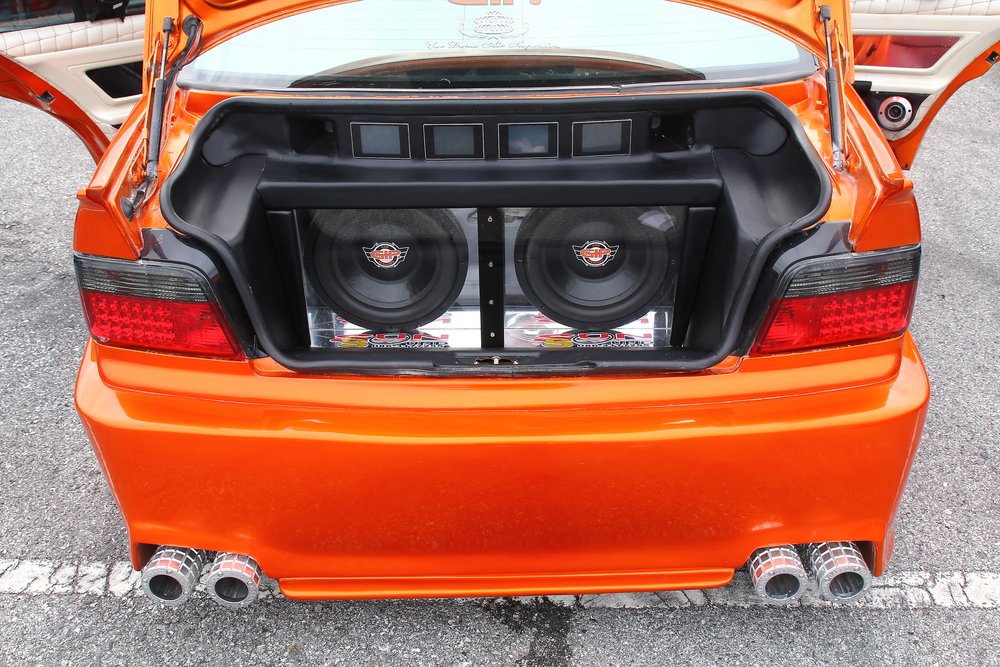
Subwoofers are large speakers built around generating low-frequency sound. They are larger in size than other speakers and need a lot of power.
Their extra size is only part of the reason they need extra power. Without getting too far into sound theory, low-frequency sounds just need more energy to be louder.
Picture music instruments in a marching band. A flute is a tiny instrument. A tuba is gigantic. When you hear the band march along, it’s probably easier to hear the little flute than the giant tuba.
Those reasons are why many audio system builds have a dedicated amp that only powers the subwoofer. Big subs need a lot of raw power to function.
Multiple Speaker Configurations
Connecting two speakers together in parallel cuts their ohm rating in half, connecting them in series doubles it. When you get beyond two, you can get tricky and dial in almost any resistance you want by combining parallel wiring with series wiring.
Honestly, if you are thinking about speaker configurations like that, you probably don’t need this guide. It’s just good for the rest of us to know that this kind of stuff is out there and might be something we encounter later on in the journey to sound perfection.
Amplifier Classes
There are 2 main amplifier classifications you will encounter in the automotive world: class A/B and class D.
Class A/B
Class A amplifiers operate at maximum power all the time to produce the best sound quality possible. Class B amplifiers are a bit more efficient, but distort easier. Both are analog amplifiers, which generally have a warmer tone and are more traditional in design.
A class A/B amplifier like the Boss R1100 combines the sound quality of a class A with a class B’s better efficiency.
Class D
Class D amplifiers such as the Rockford 500X1D are solid-state digital amplifiers. They are a lot more complicated than A/B amps, but they are much more efficient.
Compared to class A/B amps, class D amplifiers are smaller, have fewer heat problems, and use less power to generate the same volume. They are also generally more expensive.
Audio purists will claim that class D amps will never sound as good as class A/
B amps. However, as technology improves, that claim is becoming harder and harder to backup.
Audio Quality
Sound quality is perhaps the hardest thing to discuss when it comes to amps because it is subjective. Some people think clean highs are the most important thing for great audio, other people only care about the bass.
Generally speaking, an amp is considered to have poor audio quality if it distorts at higher volume. Amps are considered to have high-quality audio (like the Rockford Fosgate) if they can closely replicate the original recording at any level.
As a basic rule, higher quality amps will have higher quality audio. Higher quality internal parts will have better insulation from noise and handle higher power without losing information.
The Source Is Just as Important
No system can make a low-quality recording sound good. Streaming services and highly compressed MP3s sacrifice a lot of sound quality to keep file sizes small, so keep that in mind when buying an amp.
If you are primarily going to stream music from the internet through a Bluetooth-enabled amp, it isn’t worth buying the highest quality amp on the market. You won’t be able to take advantage of the subtle sound quality increases.
To take advantage of amazing audio quality of a premium amp you will have to dive down the rabbit hole of high-quality
formats. FLAC and 320kbps MP3 are two terms to get you started.
Other Amplifier Features
Sound quality, number of channels, and power are probably your most important considerations. Those are the core properties of every amp.
Most amps have other features, though. Some amps are incredibly feature-rich while some might only have one or two extra amenities. These extras aren’t as important as making sure the amp fits your system, but they can help you decide between two similar options.
Filters and Equalizers
Filters and equalizers are for fine-tuning the sound of your amp. An equalizer is something most people are familiar with that allows you to adjust the presence of different frequencies.
A bass-boost button or knob is sort of like a mini equalizer that only increases the low frequencies. It can add just a bit of punch to the bass of a system.
Filters are a little bit more complicated and come in three main flavors: high-pass, low-pass, and subsonic. They can be variable or fixed.
- High-pass filters strip away lower frequencies. This is good for smaller speakers that have trouble with bass or if you want to emphasize vocals. By removing the lower frequencies, the speaker can dedicate all its power to the sounds it is built to make.
- Low-Pass filters do the opposite. They strip away high frequencies. That’s great if you want to get every last drop of performance out of your subwoofer.
- Subsonic filters remove the sounds that are so low you can’t hear them.
Protection Measures
Too much power, too little power, and heat are good ways to kill electrical equipment. If you are spending a lot of money on a sound system, it’s worth getting an amp protected against those kinds of issues.
Over and under current protection do what they imply, they protect your amp and speakers from getting too much current or too little.
Automatic overheat shut off switches will power down your amp as soon as it begins to get too hot, protecting the insides from melting.
Short circuit protection is just like the GCFI in your house, it will protect your amp from wiring issues and moisture.
A waterproof amp will protect your system from water and mud. It’s great if you want to install your amp on a vehicle with no roof.
Remotes, Gimmicks and Miscellaneous Upgrades
Technology is increasing and changing the world every day, it’s simply impossible to list the massive number of features and qualities that amps can come with nowadays.
Some of those features don’t alter the function of the amp. Many amps will advertise lights and logos as features (such as the Boss Audio R1100) or remote knobs that you will set once and never touch.
Other features are ones that some people will find really useful. Things like the Bluetooth capabilities of the Rockville RXM8BTB can allow you to run the amp headless. Extra dedicated inputs and outputs can allow you to chain amps together.
At the end of the day, these little extra features will not make one amp a clear winner. However, if you have trouble deciding between two amps, and you like the fact that one lights up? Go for it.
Installing an Amp
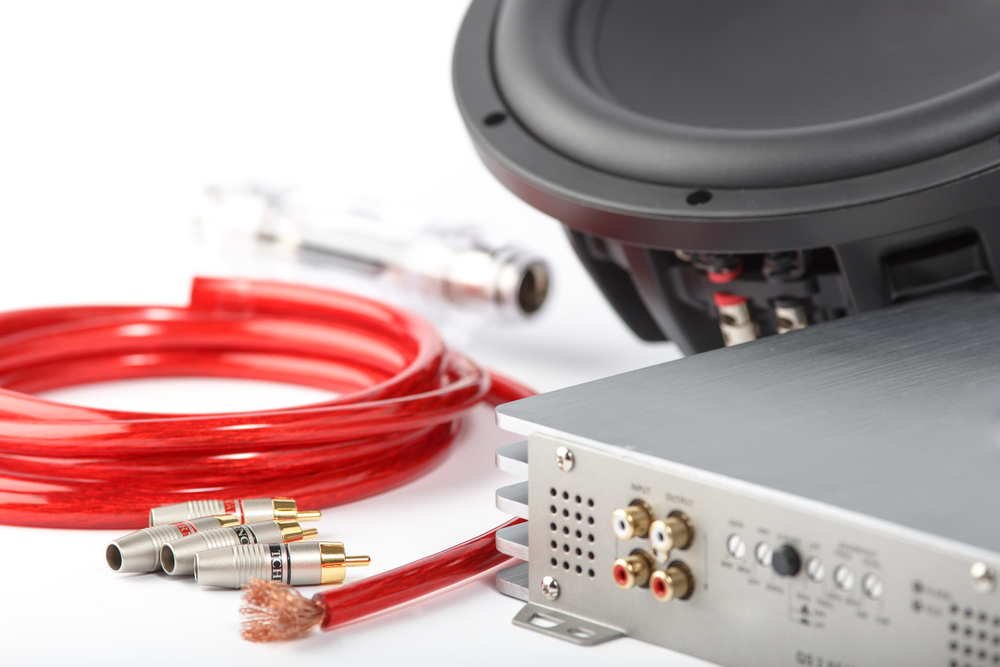
With hundreds of configurations and hundreds of different types of amps, it’s impossible to go over every scenario in this guide. You can find general write-ups everywhere around the internet, like this one from Popular Mechanics. Still, the truth is you will have to research your own specific scenario and make the best decisions based on that.
There are some important things to keep in mind, though:
- The gain switch is not a volume switch. The gain switch is for setting the sensitivity. That way, you don’t blow up your speakers. Make sure to set it properly, here’s a good video on how to do it.
- Grounding is really important. Make sure your amp is adequately grounded, since all the protections in the world won’t save your equipment from a bad ground.
- Disconnect the battery before working on the electrical. You should do that anytime you touch potentially live wires, not just when it comes to the sound system.
- Insulate and protect connections. Don’t leave miles of stripped wire laying around, that’s how you cause shorts and excess noise.
- Follow the manufacturer’s directions. Sometimes manufacturers will slip in little tips and tricks that will make your life easier. Some manufacturers also have a habit of doing things a little bit differently. If you don’t catch it, you can mess up a build pretty badly. Just be sure to at least read the manual.
Get the Earplugs Ready
Amps are great. They can take your sound system from a dud to the center of a party. Unfortunately, audio systems can be really complicated.
The good news is that people have been upgrading audio systems since cars were first invented. You have multiple generations worth of information at your fingertips. There’s nothing to be afraid of.
So get out there. Grab a set of wire strippers, a new amp and crank the volume.
